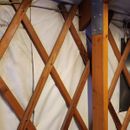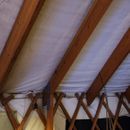Foam and vapor barrier combinations
Hello,
Here’s the setup: 700 sq ft. yurt in zone 6, lived in year round. Picture a classic circus tent and you get the picture: structure is complete round with short walls at the outside circumference and a cone shaped roof. The structure has 2×6 exposed rafters and 2×4 studs approximately 24 oc. at the outermost edge of the house. The entire structure is enclosed what I call “vinyl impregnated canvas”. We are weatherizing the yurt by insulating the walls and ceiling, and adding roof decking and siding. We are planning on a mix of DIY and pro-help. We are trying to finalize a design so we can get started ASAP since the construction season is short here.
An option just presented to us is to apply 5″ of closed cell spray foam directly to the roof canvas and approximately 3″ to the exterior wall. Lumber would be added prior to the spraying so we would have places to attach our siding and roofing.
My basic questions:
1. When using spray foam like this, is it necessary to use a smart vapor barrier in the interior?
2. As an option for saving some money, we are considering doing poly-iso ourselves on the outside wall (i.,e, spray foam only on the roof). Would this approach change the answer to #1?
I’m attaching a couple of photos of the wall and lower part of the existing ceiling. Our preference is to create “proper” exterior walls walls so the lattice is covered up.
Any thoughts or guidance would be appreciated. I’m also happy to provide sketches of ideas – we’ve been through about a million of them.
Thanks.
GBA Detail Library
A collection of one thousand construction details organized by climate and house part











Replies
You have a structure here that looks pretty similar to a pole barn in terms of the issues you'll have with insulating it. I think spray foam for the "roof" is probably your best bet here, and you absolutely want to used closed cell spray foam here. You don't need an interior side vapor barrier here.
For your question #1, NO, you do not need an interior side vapor barier when using closed cell spray foam in the way you describe in either the wall or the roof.
For your question #2, by "create proper exterior walls", do you mean frame out regular studwalls? If the answer is yes, then you'd need to build them in the usual way for your climate zone, which would mean at least enough polyiso on the exterior to meet the minimum interior:exterior insulation ratio for your climate zone. That statement assumes you'll be insulating the studbays with somethign like fiberglass or mineral wool batts though. If you want to save some money, you could build a "perfect wall", which means framing out a studwall but ONLY using the exterior polyiso for insulation. With ONLY exterior polyiso, and NO insulation between the studs, you don't have to worry about an R value ratios or moisture issues, but you WILL be limited in terms of insulating performance to however much R value you want to put up on the exterior with polyiso panels. Since you already have an exposed structure inside your yurt, this "exterior rigid foam ONLY" option might work pretty well for you. An added bonus would be having that framing on the interior to support things too.
Note that if you go with the perfect wall and spray foam the roof, you want to be sure the spray foam is applied AFTER the walls are up, so that the spray foam can tie into the top of the polyiso panels and seal around the top plate of the wall.
If that lattice and the exterior "cladding" of that canvas allows for some air movement, and you can put the polyiso between the lattice and your new studwalls, that exterior lattice acts like the furring strips in the rainscreen on a regular wall, and the canvas is your siding, in effect. That assembly should work. I would want to be sure air can circulate between the outdoors and that space acting like a "rainscreen" though. You don't want to seal that off with the vinylized canvas on the exterior and polyiso on the interior, since that would create a moisture trap and could be a problem down the road.
Bill
Seems to me the yurt is a great place to live temporary place to live while you build a permanent structure. If you want to be energy efficient in zone 6 you need an R60 roof and R25 walls.
I think applying spray foam to a flexible surface like your canvas is a bad idea as when the canvas moves you will test the bonding abilities of all the material in the assembly and the weakest bond will be reviled when it fails and things come apart.
The way I understand it yurts primary design goal is that it is portable and light weight to move. Much like nature shaped strange animals like the anteater to make the perfect fit for its niche in the world. Every part of the yurt has been lighten almost to the point of failure to make it portable. You simply don’t have the strength to support the weight insulation and the required fireproofing given your lightweight frame. Note living with exposed spray foam would be very risky from a fire point of view.
As far a heat loss goes the walls are the smallest part of your problem the huge roof is what is sucking the heat out of your home. Seems to me a big wood stove or 2 would keep the place nice and toasty R4 of the curren canvas.
Walta
Corey687,
I hope you will take this reply in the spirit that it is intended. I think this is a very bad idea.
You are essentially trying to build a cabin out of a tent. Every part of the yurt will impede you properly building the assemblies you need for a permanent structure, and at the same time you will destroy the yurt. Those practical concerns aside, I can not see how you would ever get code approval for the process you are describing.
In some ways it is akin to the shipping container conversions you see where the constraints of the existing structure are much greater than the benefits of using it.
If it were me I would design a comparably sized house using conventional building assemblies and leave the yurt as it is.
Thanks for everyone's feedback and honesty.
For better or for worse, we don't have code inspections or need for approvals where I live. As long as you disclose what you are doing, you can pretty much do what you want. I'm adding additional framing to reinforce the structure to compensate for what we are adding in the remodel. I've spoken to some builders in the area and no one has raised any red flags. It's not an ideal starting point but we have some constraints we need to work within.
One of the motivations for the renovation is that the canvas is reaching it's end of life. It's held up well but at some point will degrade and start to fail. We want to get ahead of that. Encapsulating the canvas in the stack up an option but definitely a big variable.
If the canvas is nearing end of life, I would NOT recommend applying spray foam to it. The spray foam application introduces variables (heat, possible chemical reactions with the vinyl) that could cause the material to fail. Regardless of some people claiming closed cell spray foam can beef up a structure, I do not consider it to be a structural material and would never apply it hoping it could prevent failure of the roofing materials themselves. Whatever you apply spray foam to should be entirely capable of supporting the weight of the material, and it's fairly heavy while it's curing, and it provides NO support until it's cured.
You risk having the structure collapse on you while you're doing the spray foam application, and you do NOT NOT NOT NOT NOT want a tarp covered with spray foam falling on you!!!!!!
***** I CANNOT EMPHASIZE THAT RISK ENOUGH!!! *****
Spray foam is like gooey glue, and with that and the canvas falling on you, I think there is a very good chance the installer would be killed, due to the materials basically entombing the people inside with no way to extricate them from the sticky, gooey mess as it asphyxiates them.
BTW, even if you're in an area without code enforcement, it's still a good idea to build to code for your own safety.
Bill